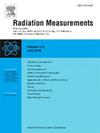CdZnTe在宽带多用途辐射探测中的初步研究
IF 2.2
3区 物理与天体物理
Q2 NUCLEAR SCIENCE & TECHNOLOGY
引用次数: 0
摘要
考虑到传统半导体(如Si和Ge)在高能辐射环境中的局限性,在本研究中,我们展示了CdZnTe (CZT;(II-IV化合物半导体)在探测和区分辐射在很宽的能量范围。采用垂直布里奇曼法生长1英寸CZT晶体,并进行后处理制备辐射探测器。6 × 6 × 8 mm3 CZT样品的电阻率为1.9 × 1010 Ω cm,降低了电噪声,提高了信号精度。使用a137Cs源,我们实现了4.3%的能量分辨率,突出了CZT在核医学应用中的潜力。此外,还测试了其在诊断和治疗医疗设备中的性能。暴露在计算机断层扫描x射线下产生随施加电压的线性电流密度,证实探测器符合欧姆定律,高电子-空穴对浓度和快速载流子迁移率。用6 mv光子和6 mev电子束测试表明,探测器的相对强度与光束剂量呈线性关系,证实了探测器的响应是一致的。这种线性减少了诊断和治疗计划的不确定性,强调了CZT的实际益处。在不同辐射剂量下的反复试验验证了CZT探测器的准确性和一致性。由于其广泛的能量敏感范围,高能量分辨率和对光子和电子束的线性响应,CZT成为辐射探测,医学成像和核医学应用的多用途候选材料。本文章由计算机程序翻译,如有差异,请以英文原文为准。
Preliminary study of CdZnTe for multipurpose radiation detection in broadband applications
Considering the limitations of traditional semiconductors, such as Si and Ge, in high-energy radiation environments, in this study, we demonstrated the reliable and efficient performance of CdZnTe (CZT; II–IV compound semiconductor) in detecting and distinguishing radiation across a wide energy range. A 1-inch CZT crystal was grown using the vertical Bridgman method and subjected to post-processing to prepare radiation detectors. A 6 × 6 × 8 mm3 CZT sample exhibited a resistivity of 1.9 × 1010 Ω cm, which indicated reduced electrical noise and improved signal accuracy. Using a137Cs source, we achieved an energy resolution of 4.3 %, highlighting the potential of CZT for nuclear medicine applications. Additionally, its performance in diagnostic and therapeutic medical devices was tested. Exposure to computer tomography X-rays resulted in a linear current density with applied voltage, confirming the detectors' adherence to Ohm's law, high electron–hole pair concentration, and fast charge-carrier mobility. Testing with 6-MV photon and 6-MeV electron beams demonstrated the linearity between the detector's relative intensity and beam dose, confirming a consistent detector response. This linearity reduces uncertainty in diagnosis and treatment planning, emphasizing the practical benefits of CZT. Repeated trials at various radiation doses verified the accuracy and consistency of the CZT detector. Owing to its broad energy-sensitivity range, high energy resolution, and linear response to photon and electron beams, CZT emerges as a multipurpose candidate for radiation detection, medical imaging, and nuclear medicine applications.
求助全文
通过发布文献求助,成功后即可免费获取论文全文。
去求助
来源期刊

Radiation Measurements
工程技术-核科学技术
CiteScore
4.10
自引率
20.00%
发文量
116
审稿时长
48 days
期刊介绍:
The journal seeks to publish papers that present advances in the following areas: spontaneous and stimulated luminescence (including scintillating materials, thermoluminescence, and optically stimulated luminescence); electron spin resonance of natural and synthetic materials; the physics, design and performance of radiation measurements (including computational modelling such as electronic transport simulations); the novel basic aspects of radiation measurement in medical physics. Studies of energy-transfer phenomena, track physics and microdosimetry are also of interest to the journal.
Applications relevant to the journal, particularly where they present novel detection techniques, novel analytical approaches or novel materials, include: personal dosimetry (including dosimetric quantities, active/electronic and passive monitoring techniques for photon, neutron and charged-particle exposures); environmental dosimetry (including methodological advances and predictive models related to radon, but generally excluding local survey results of radon where the main aim is to establish the radiation risk to populations); cosmic and high-energy radiation measurements (including dosimetry, space radiation effects, and single event upsets); dosimetry-based archaeological and Quaternary dating; dosimetry-based approaches to thermochronometry; accident and retrospective dosimetry (including activation detectors), and dosimetry and measurements related to medical applications.
 求助内容:
求助内容: 应助结果提醒方式:
应助结果提醒方式:


